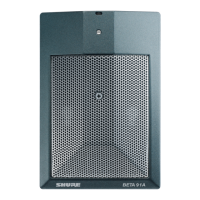Shure Incorporated
3/8
•
•
•
•
•
•
•
•
•
•
•
•
•
•
•
BETA91A
Half-Cardioid Condenser Microphone
General Description
The Shure Beta 91A is designed for use with kick drums, piano and other traditional low frequency applications. Tailored for
bass-heavy environments, this microphone features a powerful low frequency response and integrated preamplifier and XLR
connection for easy setup and minimal stage clutter. The Beta 91A combines superior attack and punch for studio-quality
sound, even at extremely high sound pressure levels (SPLs).
Features
Premier live performance microphone with Shure quality, ruggedness, and reliability
Uniformhalf-cardioidpolarpattern(inthehemisphereabovemountingsurface)formaximumgainbeforefeedbackandre-
jection of off-axis sound
Tailored frequency response for kick drums and bass-heavy instruments
Wide dynamic range for use in high SPL environments
Two-position contour switch enhances attack and clarity
Integrated preamp and XLR connector reduce stage clutter and provide a quick, secure setup
Low profile design requires no external mounting hardware
Steel grille and die-cast metal construction resist wear and abuse
Applications
General Rules for Use
This table lists the most common applications and placement techniques. Keep in mind that microphone technique is largely a
matter of personal taste; there is no one "correct" microphone position.
Aim the microphone toward the desired sound source; angle unwanted sounds toward its null point.
Use the fewest amount of microphones as practical to increase the Potential Acoustic Gain and prevent feedback.
Follow the 3 to 1 Rule by spacing each microphone by at least three times the distance to its source to reduce Phase Can
cellation.
Place microphones as far as possible from reflective surfaces to reduce Comb Filtering.
When using directional microphones, work closely to the microphone for extra bass response to take advantage of Prox
imity Effect.
Avoid excessive handling to minimize pickup of mechanical noise and vibration.
Do not cover any part of the microphone grille, as this will adversely affect microphone performance.
Applications and Placement
Locationandroomacousticsstronglyaffectthesoundqualityofmicrophones.Toachievethebestoverallsoundforaparticu-
lar application, it may be necessary to experiment with microphone placement and room treatments.

